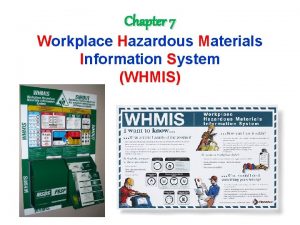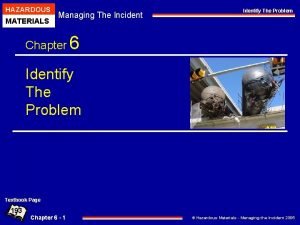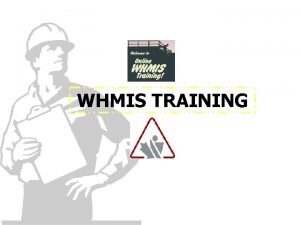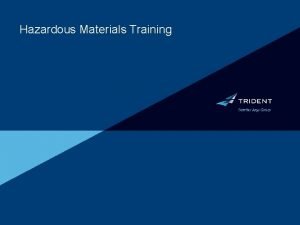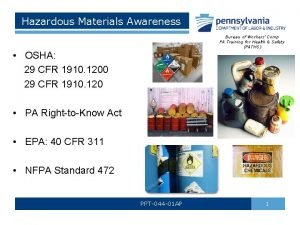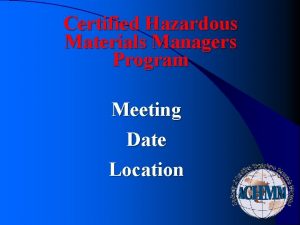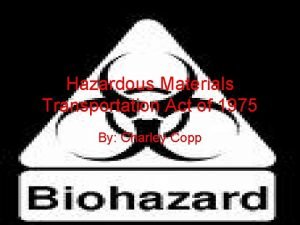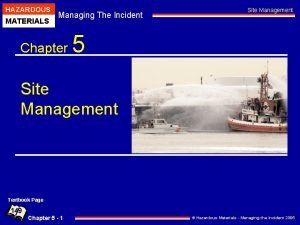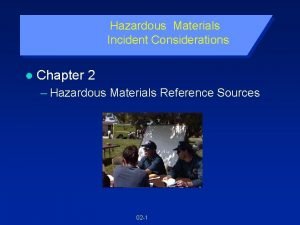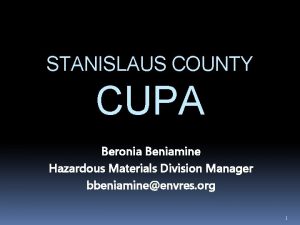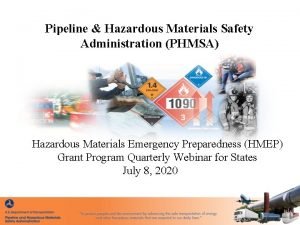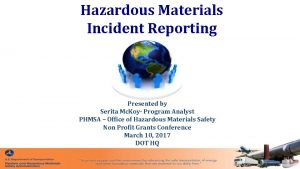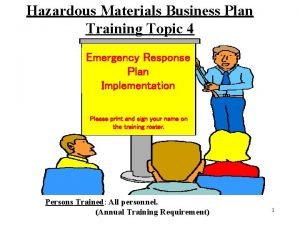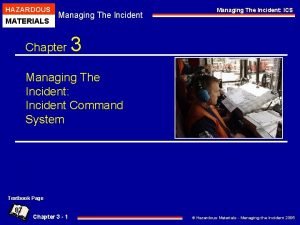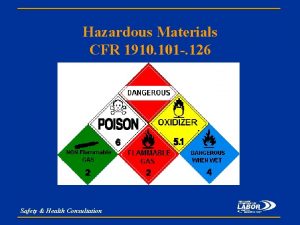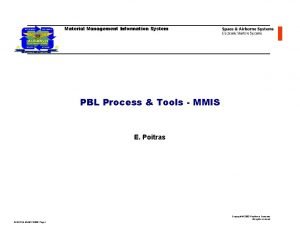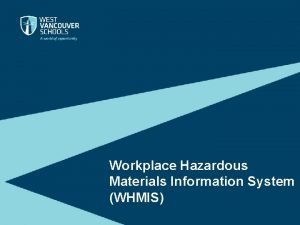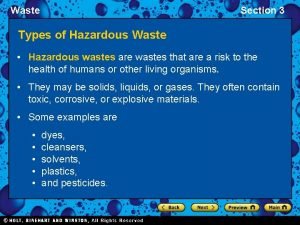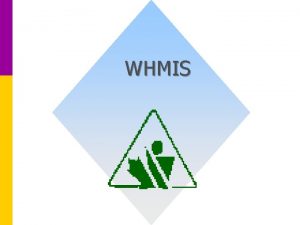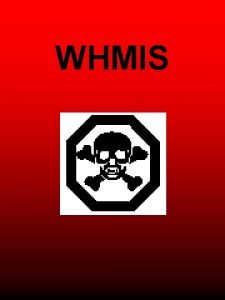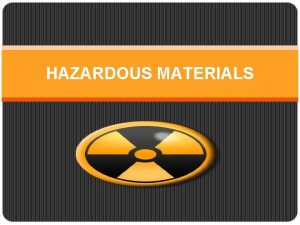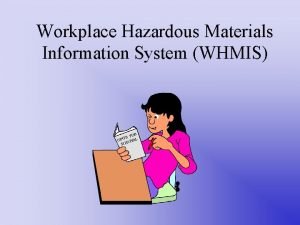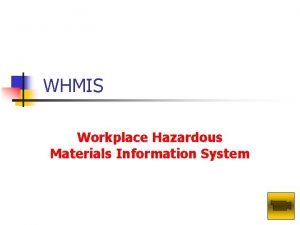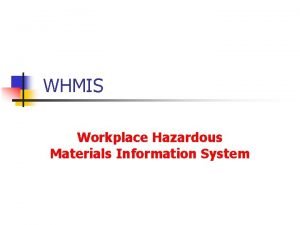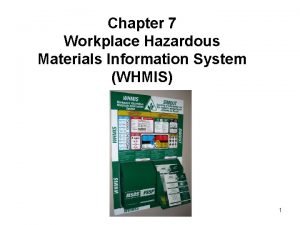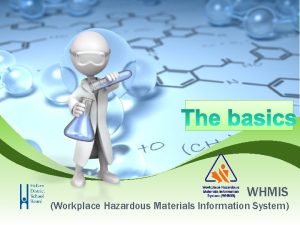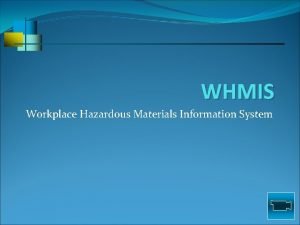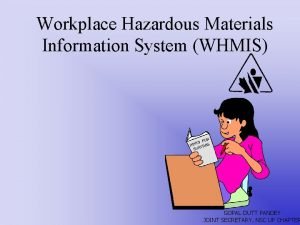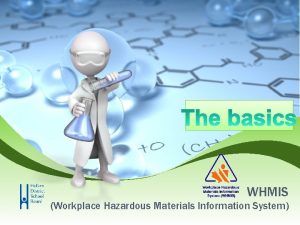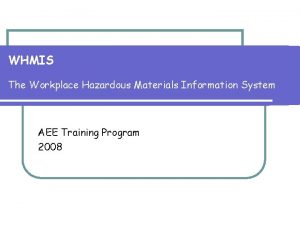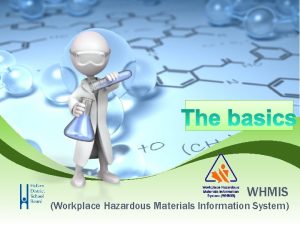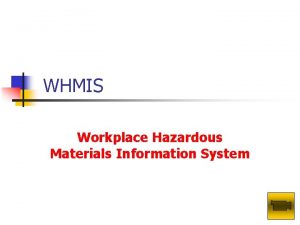WHMIS Workplace Hazardous Materials Information System Right to




























- Slides: 28

WHMIS Workplace Hazardous Materials Information System

“Right to Know” Worker’s have access to information through their employer.

Purpose of WHMIS • Provides Information on Hazardous Materials used in Workplace • Facilitates the Process of Hazard Identification • Ensures Consistency of Information in all Canadian Workplaces

Legislation Federal – Bill C-70 – Part of the Canada Labour Coded Provincial – Bill 79 – Ontario Reg. 644/88 – Occupational Health & Safety Act – Policed by Ministry of Labour

Exemptions From WHMIS • Explosives • Drugs • Pesticides • Radioactive Materials • Hazardous Wastes • Products being transported – T. D. G. Act • Consumer Products/Tobacco/Manufactured Articles

Three Components of WHMIS • Labels – Supplier Label – Workplace Label • Material Safety Data Sheets (MSDS) • Worker Education

Duties of the Supplier • Classify Product • Apply Supplier Label • Provide Material Safety Data Sheet • Update MSDS’s at least every 3 years

Duties of the Employer • Conduct Workplace Inventory • Ensure Proper Labeling is Used • Label Piping Systems/Vessels/Reactors • Maintain and Make Available MSDS’s • Train Workers

Duties of a Worker • Report missing or damaged labels or MSDS’s • Participate in Training • Apply Knowledge and Training

WHMIS Hazard Classifications

Class A • Compressed Gas – Any Hazardous Material that is contained under pressure including compressed gas, dissolved gas, or liquefied gas

Compressed Gas Cylinders • store and transport with safety cap • comply with storage restrictions • DO NOT store fuel gas with oxygen • secure in an upright position • use in a well ventilated area

Class B • Flammable and Combustible Material – Flammable Gases – Flammable and Combustible Liquids – Flammable Solids – Flammable Aerosols – Reactive Flammable Material • Methanol, Toluene, Butane, Acetone

Flammable Materials • Store liquids in Flammable Storage Cabinet • Explosion-proof fixtures required • NEVER store with oxidizers • Keep away from heat, ignition sources, and direct sunlight • Use static lines when transferring

Class C • Oxidizing Material – Any Hazardous Material which causes or contributes to the combustion of another material by giving oxygen or some other oxidizing substance, whether or not it is combustible. – Organic Peroxides • Chlorates, Nitric Acid, Peroxides, Permanganates, Perchlorates, Nitrites, Nitrates

Oxidizers • Easily oxidize metal powders, organic materials • Segregate from other materials, such as organic solvents • PPE and/or explosion barriers may be required

Class D 1 • Poisonous & Infectious Materials – Material causing immediate and serious toxic effects – Materials which are potentially fatal or may cause permanent damage if inhaled, swallowed, or absorbed through the skin, or may burn the skin or eyes upon contact

Class D 2 • Poisonous & Infectious Materials – Material causing other chronic or long term effects – Material which may • cause death or permanent damage as a result of repeated exposure over an extended period of time; • may be an irritant to the skin, eyes, or respiratory system; • may cause cancer, birth defects, or sterility.

Class D 3 • Poisonous & Infectious Materials – Biohazardous and Infectious Materials – Materials which may cause disease in humans and animals, such as viruses, bacteria, and fungi; may also include cultures and diagnostic specimens such as blood, urine, and body tissue.

Class E • Corrosive Material – Material which may corrode aluminum and steel or human flesh – Material which are anhydrous corrosive gases

Inorganic Acids • Sulfuric Acid, Nitric Acid, Perchloric Acid, Hydrochloric Acid • Segregate from bases and organic compounds • Store in a ventilated acid cabinet • Know the location of eye washes and safety showers • Store on lower shelves

Bases • Sodium hydroxide, ammonium hydroxide • Segregate from acids and organic compounds • Store in a ventilated cabinet • Know the location of eye washes and safety showers • Store on lower shelves

Class F • Dangerously Reactive Material – Materials which undergo vigorous polymerization, decomposition, or condensation – Materials which become self-reactive under conditions of shock, or increased temperature or pressure – Materials which react vigorously with water to produce a very toxic gas

WHMIS Labels

Supplier Label • Product Identifier • Hazard Symbols • Border • Bilingual • Risk Phrases and Precautions • First Aid • Safe Handling Precautions • Reference to MSDS • Supplier Information

Workplace Label • Product Identifier • Safe Handling Precautions • Reference to MSDS

Workplace Label Uses • Transfer of material from a Supplier Labelled container to another container • Replacement of a damaged Supplier Label

MSDS Contents • Hazardous Ingredients • Product Information • Preparation Information • Physical Data • Fire & Explosion Hazard • Reactivity Data • Toxicological Properties • Preventative Measures • First Aid Measures
 Workplace hazardous materials information system (whmis)
Workplace hazardous materials information system (whmis) Right product right place right time right price
Right product right place right time right price Right time right place right quantity right quality
Right time right place right quantity right quality Hazardous
Hazardous 3 basic components of whmis
3 basic components of whmis Hazardous material table
Hazardous material table Hazardous materials table
Hazardous materials table Pa-psfa-hazardous materials awareness
Pa-psfa-hazardous materials awareness Chmm accreditation training
Chmm accreditation training Hazardous materials transportation act of 1975
Hazardous materials transportation act of 1975 Hazardous materials managing the incident
Hazardous materials managing the incident Hazardous materials reference books
Hazardous materials reference books Stanislaus county hazardous waste
Stanislaus county hazardous waste Pipeline and hazardous materials administration
Pipeline and hazardous materials administration Hazardous materials incident report
Hazardous materials incident report Hazardous materials business plan
Hazardous materials business plan Hazardous materials managing the incident
Hazardous materials managing the incident Compressed gas association pamphlet p-1-1965
Compressed gas association pamphlet p-1-1965 The right man on the right place at the right time
The right man on the right place at the right time Material information system
Material information system Four parts of whmis system
Four parts of whmis system Cant stop the feeling go noodle
Cant stop the feeling go noodle Difference between useful and harmful materials
Difference between useful and harmful materials Natural materials and man made materials
Natural materials and man made materials Differentiate adopting materials and adapting materials
Differentiate adopting materials and adapting materials Direct materials budget with multiple materials
Direct materials budget with multiple materials Section 3 hazardous waste answers
Section 3 hazardous waste answers Aviation hazardous attitudes
Aviation hazardous attitudes Hazardous waste neha
Hazardous waste neha
